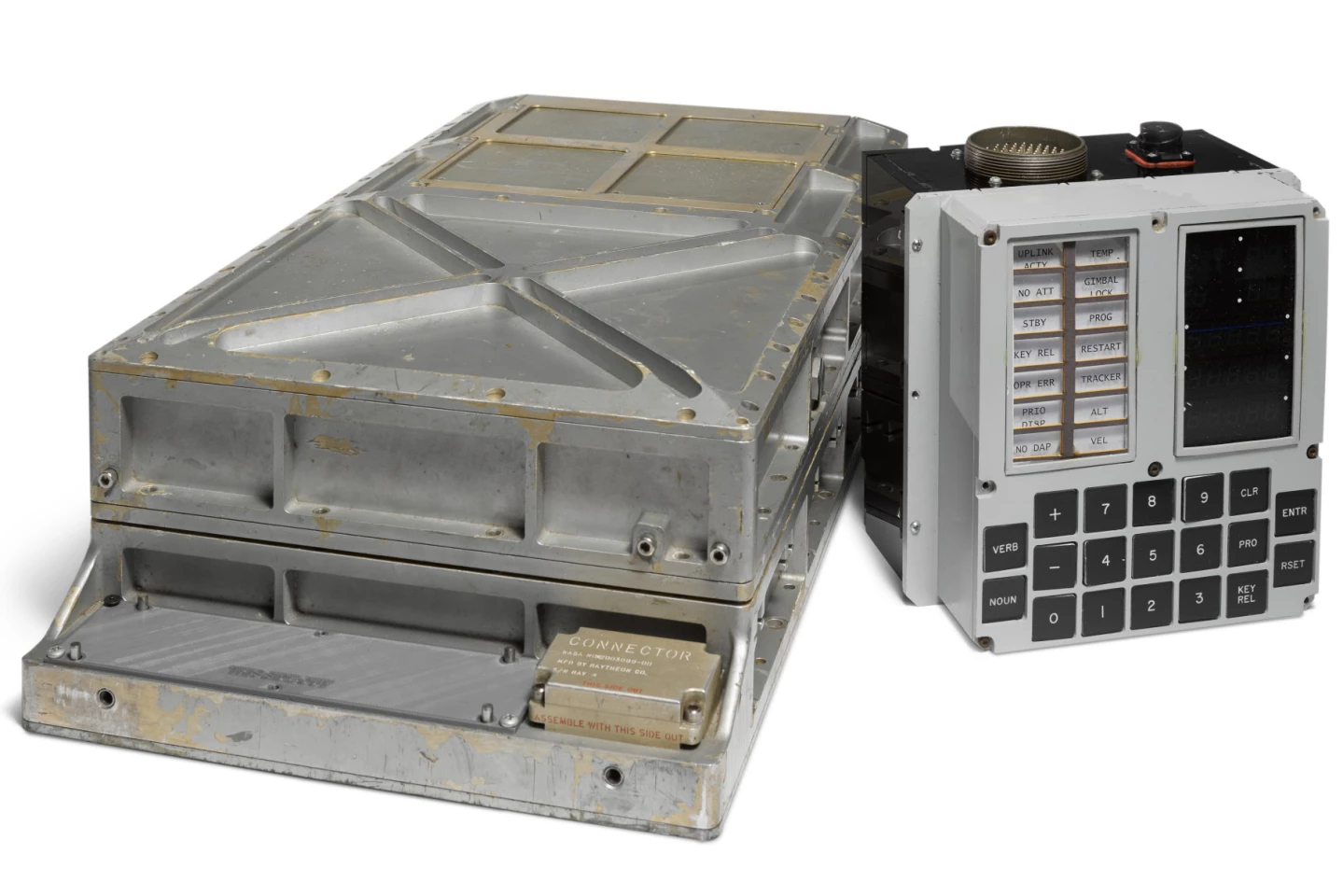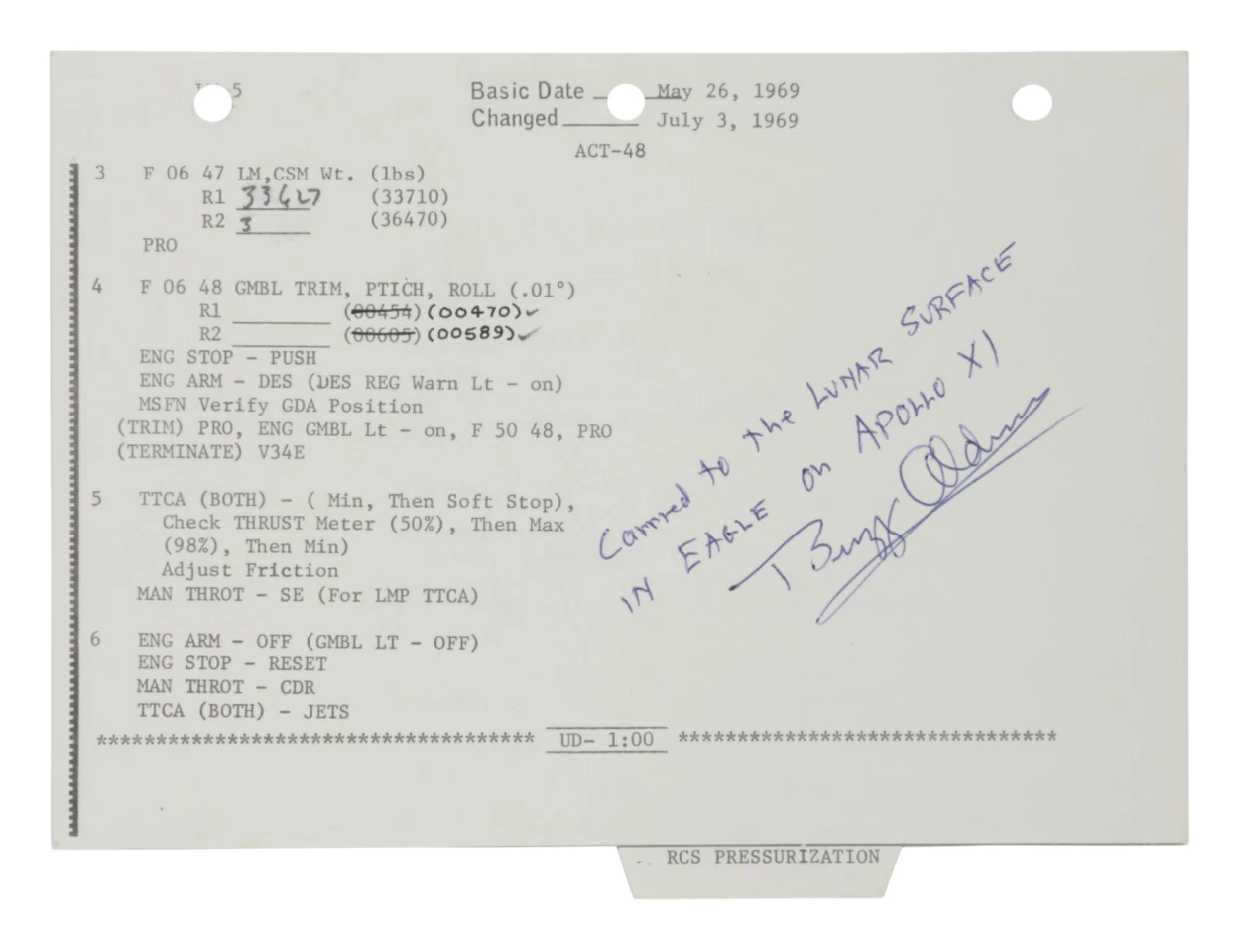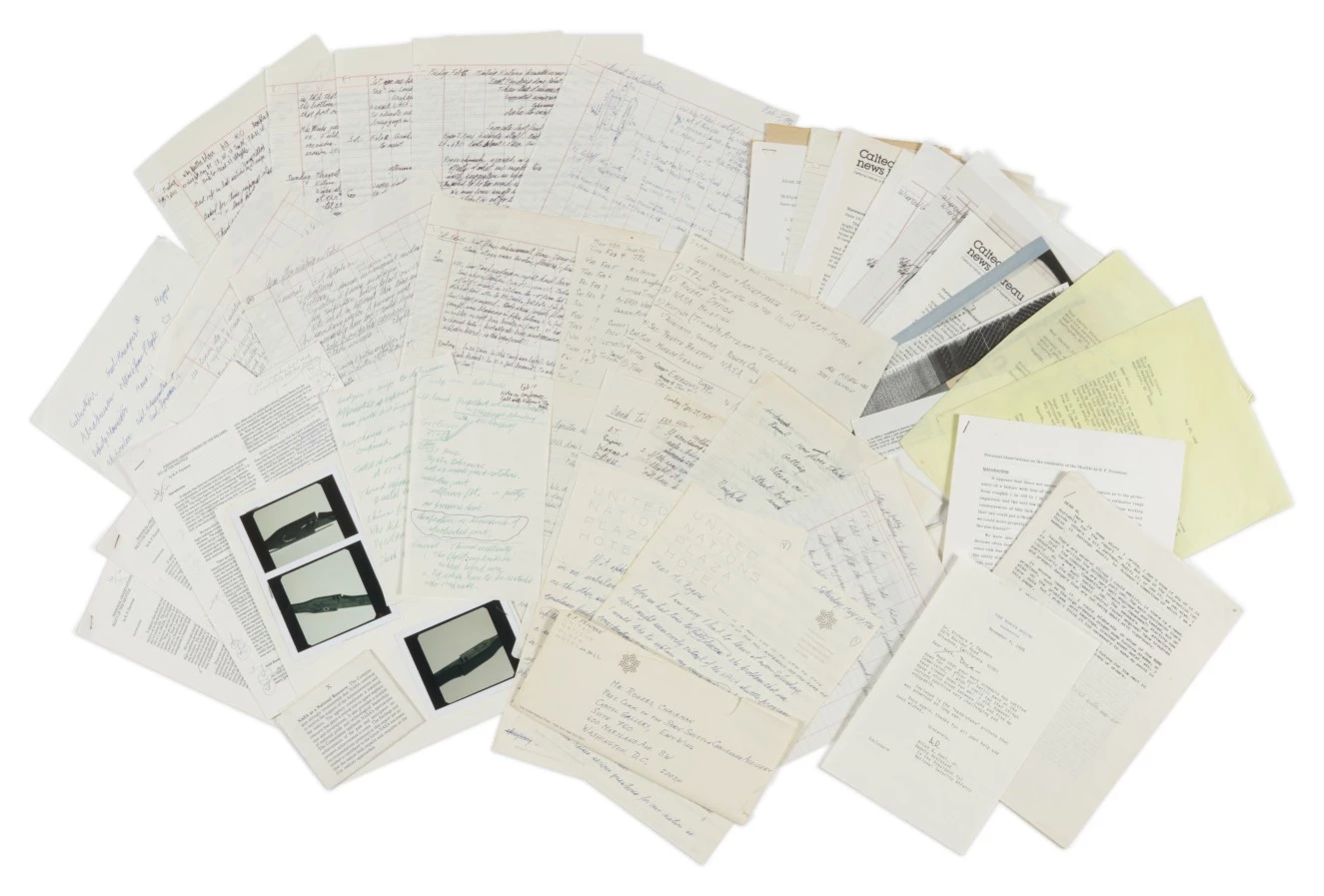Last week was a big week in space exploration, with the 52nd anniversary of the Apollo 11 moon landing, and some significant sales of space memorabilia, including US$746,000 for an Apollo Guidance Computer (the brain behind the Lunar landing), $119,700 for a rare 1962 Krechet-94 ("Gyrfalcon") lunar spacesuit, $63,000 for Neil Armstrong’s annotated Lunar Surface Flown Checklist and $250,000 for a Type-2 Phaser pistol from the original 1967 TV Space Opera, Star Trek.
We’ve been arguing for two decades that scientific and aerospace memorabilia is underpriced at auction, and several results this week suggest it is moving upwards in price with the rest of the memorabilia smashing records in the COVID Collectibles Bonanza.
$746,000 | Apollo Guidance Computer

One of the most significant machines in the history of mankind, only 75 Apollo Guidance computers were ever made, and on average, they each cost the United States around $200,000 (equivalent to $1.5 million today). Designed in the early 1960s, the Apollo Guidance Computer (AGC) was created solely for the Apollo space program, and was one of the first, if not the first, computer using integrated circuits. That's a full decade prior to the first commercially available microprocessor – the 4-bit Intel 4004 central processing unit (CPU) that was released in 1971.
We ran a feature article on this remarkable machine in 2019 on the 50th anniversary of the Moon landing.
As a point of reflection, it’s worth noting that the smartphone in your pocket is most likely more than a million times more powerful than the AGC, so although the AGC is just over 50 years old, it is ancient in terms of computers.
The Apollo Guidance Computer was a technical marvel: in the era of room-sized computers, NASA allocated one cubic foot on their spacecraft for the electric brain that would be responsible for guiding humans to the lunar surface and safely returning them home. It was up to the best and brightest at the MIT Instrumentation Lab to make it fit.
Rather than using the large vacuum tubes or big discrete transistors typical in computers of the time, MIT engineers pioneered the application of integrated circuits – microchips – to accomplish the same task in a diminutive package. During 1963, the Instrumentation Lab consumed 60 percent of the integrated circuit production in the United States, and by 1964 Fairchild Industries had shipped more than 100,000 ICs for use in the Apollo program.
The AGC hardware was thus a combination of cutting-edge technology and old-school craftsmanship: while these innovative, mass-produced chips made their way into the AGC's logic modules, the computer's mission-critical software was stored in handmade "rope memory," contained inside its fixed memory modules, which could not be erased, altered, or corrupted.
This rope memory required absolute precision and was sewn by workers recruited from local textile factories: copper wire was woven in and around ring-shaped magnetic cores, with each wire threaded through the core representing a binary "1," and each wire bypassing the core representing a "0." It took eight weeks for the workers to weave the memory for a single flight computer, at a cost of $15,000 per module.
The price fetched by the Apollo Guidance Computer is also the most significant sale of the computer to date. The last AGC to reach auction sold for $279,859 at RR Auction in October 17, 2019, which was itself a record well above any previous sale.
The interface for the AGC is known as the Apollo Guidance Computer Display and Keyboard (DSKY) and RR Auction also sold a DSKY for a record $210,261 in April, 2019, when the previous record had been just $93,750, so it appears that space memorabilia is also appreciating in value rapidly.
$119,700 | Krechet-94 ("Gyrfalcon") lunar spacesuit

Spacesuits have traditionally sold for peanuts at auction, so the price of this suit is quite a surprise. An early Gemini spacesuit worn by Neil Armstrong fetched US$109,375 in November, 2018. The suit had been worn aboard Gemini 8, the 1966 mission that performed the first docking of two spacecraft in flight.
In 2018, a Gemini G-2C-4 Full High Altitude Pressure Suit fetched $162,500 at Sotheby’s. The space suit was complete and authentic in every respect, and very few such space suits make it out of captivity and become available for private ownership.
Such complete suits have in every other instance been bequeathed by NASA to a museum, usually the Smithsonian.
By comparison, the (fictional) space suit worn by Ripley (Sigourney Weaver) in the 1979 science fiction movie Alien, fetched $204,800 at auction in 2018, the spacesuit and helmet of Dr. David Bowman (Keir Dullea) from 2001: A Space Odyssey fetched $370,000 in 2020 and Darth Vader’s mask and helmet from Star Wars: The Empire Strikes Back sold for $1.152 million in 2020. Maybe the rise of sci-fi memorabilia values is bringing with it an appreciation of the real deal memorabilia.
$63,000 | Lunar Surface Flown Checklist sheet with notations by Neil Armstrong

This artifact of history is from the personal collection of Apollo 11 Lunar Module Pilot Buzz Aldrin and was carried to the lunar surface during the first Moon landing. It is a single 6 x 8-inch sheet printed recto and verso, with "RCS PRESSURIZATION" on a tab on both sides, providing the steps to take in order to properly activate Eagle (the Lunar Landing Module) in preparation for the first ever lunar landing. The sheet is signed and inscribed in blue ink by Buzz Aldrin, "carried to the lunar surface in eagle on Apollo XI / buzz aldrin", with two lines of numerical annotations and two check marks in black felt-tip pen by mission commander Neil Armstrong.
$44,100 | Richard Feynman's archive of the Challenger disaster

This archive consists of Richard Feynman's handwritten notes, drafts of his report, autographed letter to William Rogers, and other materials relating to his work as part of the Rogers Commission to Investigate the Space Shuttle Challenger disaster, February-November, 1986.
$21,420 | Kathy Sullivan's twice-flown Seiko — 615 km high and 10 km low

Worn by the “most vertical girl”, Astronaut Kathy Sullivan on two space flights and to the depths of the ocean, this Seiko A829-6019 Astronaut Sports 100 Alarm Chronograph is hence the “most vertical watch.”
The watch was flown on Sullivan's wrist aboard both STS-41G (October 5-13, 1984), and STS-31 (in April 1990, to an altitude of 332 nautical miles [615 km]), and then taken by her to the Challenger Deep (7 June, 2020, to a depth of 10,925 meters).
$20,160 | "Sunrise over Antares" by Alan Bean

When Alan LaVern Bean (1932-2018) passed away in 2018 at the age of 86, he was remembered primarily for his part in the Apollo 12 mission, when he became the fourth person to set foot on the Moon, just four months after Neil Armstrong and Buzz Aldrin became the first moonwalkers. However, when the astronaut left NASA in 1981 he undertook a major life change and began to pursue painting full time (to the surprise of his astronaut peers). He would later go on to say “I think of myself not as an astronaut who paints, but as an artist who was once an astronaut.”
In Apollo – An Eyewitness Account by Astronaut / Explorer Artist / Moonwalker Alan Bean, Bean recounts: "I painted the view to the east past the Apollo 14 lunar module Antares shortly after Alan Shepard and Ed Mitchell began their trek toward Cone Crater. The Sun is just peeking over the top of their spaceship, making it difficult, even painful, to look that way. It's the same Sun we see here on Earth, but it appears much brighter because there is no atmosphere on the Moon to partially screen its brilliant rays. Cone Crater sits on top of the high ground that's in the distance beyond the flag, and Al and Ed are walking into the Sun as they move along. Even with their gold visors in place, the glare makes it difficult for them to navigate.
"Al and Ed made their landing descent with the Sun at their backs; this was an important consideration in planning the time of landing, because it was necessary to land when the Sun was relatively low in the lunar sky, so that the long shadows would help Al and Ed spot craters and rocks to avoid. Without shadows as a visual aide, accurately judging height to make a safe touchdown would have been an even more difficult and dangerous task.
"The sky is painted just the way it looks up there: black. Not a flat black, but a shiny, patent leather black. I could not see stars while walking on the Moon because the Sun made the surface so bright that the irises of my eyes closed way down. It's a little like walking out of a brightly lit room and looking up at a dark, clear night sky."
$250,000 | Type-2 Phaser pistol from Star Trek

In 1965, two “space opera” science fiction television series emerged and the baby boomer generation’s perception of the future was changed forever. Lost in Space and Star Trek both gained massive followings during the height of broadcast television’s reach into the population, but the rudimentary media ratings tools of the day measured the size of the audience, but not its devotion.
Both series ran for just three seasons before they were axed shelved, yet Star Trek was reprised several years later due to the high ratings it achieved during global TV syndication in the 1970s, and the new series nurtured a global cult following because it resonated with its audience in a powerful and unprecedented manner.
The original three-series Star Trek run subsequently catalyzed 13 movies, nine spin-off television series (and two more on the way), a gigantic merchandise industry of toys, trading cards, games of every type, a new language (Klingon, now spoken by the true believers) and it inspired countless other science fiction franchises, most notably Star Wars.

While Star Trek sowed the imaginative seeds that have catalyzed countless sunrise industries, from private space travel, through to artificial intelligence and robotics, one of the technologies that seems to have most caught the imagination was the concept of directed energy weapons as personified by the Type-2 phaser pistol.
Measured by the prices fetched at auction, the phaser has become one of the defining icons of American pop culture. Though still well shy of Han Solo's Jedi blaster gun ($562,500) and Luke Skywalker’s lightsaber ($450,000), it became one of the top 10 most valuable movie weapons in history with this sale, beating the previous record of $192,500 for a Type-2 phaser pistol.












